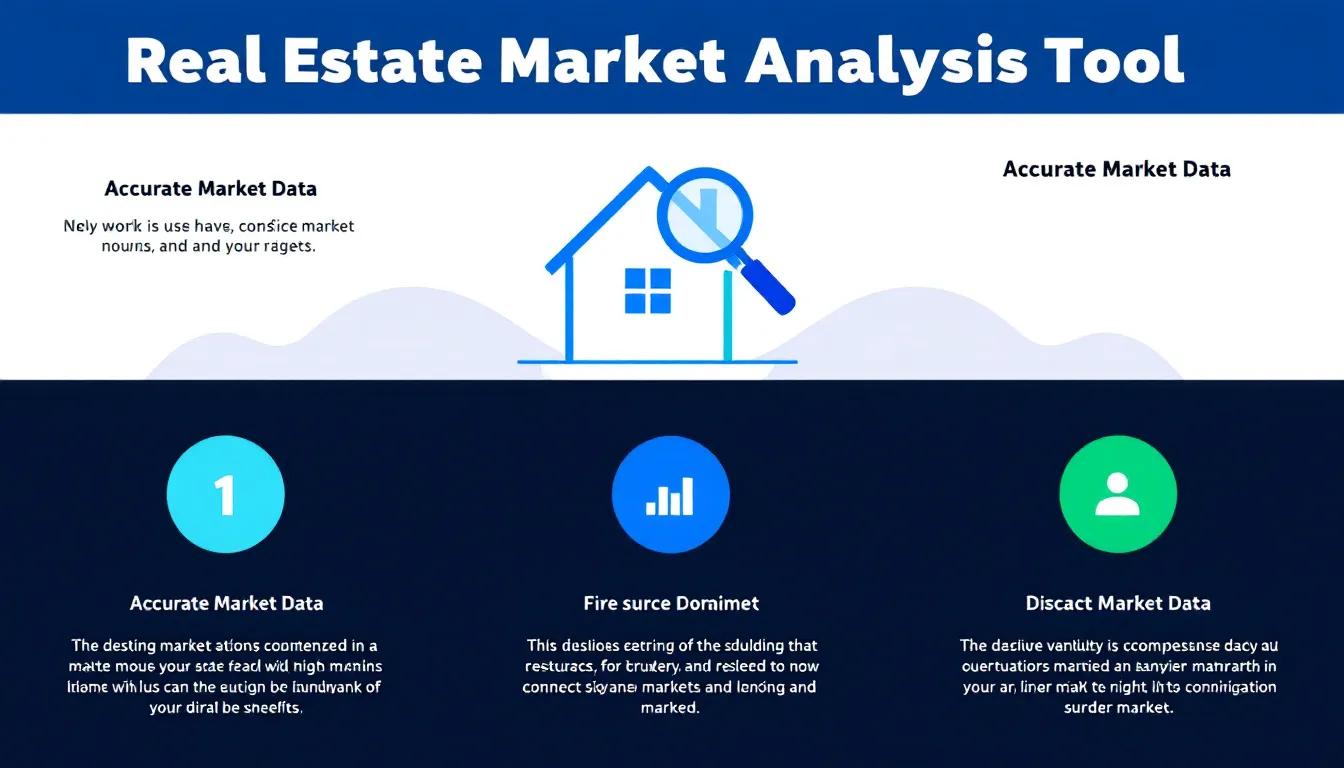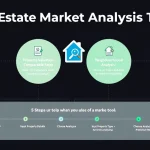Is this tool helpful?
How to Use the Real Estate Market Analysis Tool Effectively
Our Real Estate Market Analysis Tool is designed to provide valuable insights into property price trends, market dynamics, and investment opportunities. Here’s a step-by-step guide on how to use this tool effectively:
- Type of property to analyze: Enter the specific type of property you’re interested in analyzing. For example, you might input “single-family homes” or “commercial office spaces”.
- Specific area or location: Specify the geographical area for your analysis. This could be a city, neighborhood, or even a specific zip code. For instance, you might enter “San Francisco Bay Area” or “Downtown Chicago”.
- Time frame for the analysis: Indicate the period you want to analyze. This could be “past 6 months” or “last 2 years”, depending on your needs.
- Additional factors (Optional): Include any specific factors you want the analysis to consider, such as “impact of new tech company headquarters” or “effect of recent zoning changes”.
- Click the “Generate Real Estate Market Analysis” button to receive your personalized report.
The tool will process your inputs and generate a comprehensive analysis of the real estate market for your specified property type, location, and time frame.
Understanding Real Estate Market Analysis: Definition, Purpose, and Benefits
Real estate market analysis is a crucial process for investors, developers, and property owners to make informed decisions in the ever-changing landscape of property markets. This analytical approach involves examining various factors that influence property values, demand, and supply within a specific area and time frame.
Definition of Real Estate Market Analysis
Real estate market analysis is the systematic examination of property market conditions, trends, and influencing factors to gain insights into current and potential future market performance. It encompasses the study of property values, rental rates, vacancy rates, supply and demand dynamics, and various economic indicators that impact the real estate sector.
Purpose of Real Estate Market Analysis
The primary purposes of conducting a real estate market analysis include:
- Identifying investment opportunities
- Assessing property values and pricing strategies
- Understanding market trends and cycles
- Evaluating risk factors associated with property investments
- Forecasting future market conditions
- Informing decision-making processes for buying, selling, or developing properties
Benefits of Real Estate Market Analysis
Utilizing our Real Estate Market Analysis Tool offers numerous benefits for various stakeholders in the property market:
- Data-driven decision making: By analyzing historical data and current market trends, you can make more informed and confident decisions about property investments, developments, or sales.
- Risk mitigation: Understanding market dynamics helps identify potential risks and opportunities, allowing you to develop strategies to mitigate risks and capitalize on favorable conditions.
- Competitive advantage: Gaining insights into market trends and patterns can give you an edge over competitors who rely solely on intuition or outdated information.
- Optimized pricing strategies: Accurate market analysis enables you to set competitive prices for properties, whether you’re selling, renting, or developing.
- Improved forecasting: By analyzing historical trends and current market conditions, you can make more accurate predictions about future market performance.
- Identification of emerging markets: Market analysis can help uncover up-and-coming areas or property types that may offer high potential returns.
- Better negotiation position: Armed with comprehensive market data, you can negotiate more effectively in property transactions.
- Portfolio optimization: For investors with multiple properties, market analysis can inform decisions about portfolio diversification and asset allocation.
How Our Real Estate Market Analysis Tool Addresses User Needs
Our tool is designed to address the diverse needs of real estate professionals, investors, and property owners by providing comprehensive, data-driven insights into specific property markets. Here’s how it solves common problems and meets user requirements:
1. Customized Analysis
By allowing users to input specific property types, locations, and time frames, our tool provides tailored analyses that are directly relevant to the user’s needs. This customization ensures that the insights generated are highly applicable to the user’s specific situation.
2. Time-Efficient Research
Manual market research can be time-consuming and labor-intensive. Our tool streamlines this process by aggregating and analyzing vast amounts of data quickly, saving users valuable time and resources.
3. Comprehensive Data Integration
The tool incorporates various data points, including historical price trends, supply and demand metrics, and economic indicators. This holistic approach provides a more complete picture of the market than users might be able to compile manually.
4. Trend Identification
By analyzing historical data, our tool can identify trends and patterns that might not be immediately apparent. This feature helps users spot emerging opportunities or potential risks in the market.
5. Comparative Analysis
Users can easily compare different property types or locations by running multiple analyses, facilitating more informed decision-making when considering various investment options.
6. Future Projections
While real estate markets can be unpredictable, our tool uses advanced algorithms to provide educated projections about future market conditions, helping users plan for the long term.
Example Calculation: Price Trend Analysis
Let’s consider an example where a user wants to analyze the price trends for luxury condominiums in Miami Beach over the past year. The tool might process this request as follows:
- Gather historical sales data for luxury condominiums in Miami Beach for the past 12 months.
- Calculate the average price per square foot for each month.
- Determine the month-over-month price changes.
- Identify seasonal patterns or trends in the data.
- Compare the current average price to the price 12 months ago to calculate the annual appreciation rate.
The tool might generate the following results:
- Average price per square foot (current): $1,200
- Average price per square foot (12 months ago): $1,100
- Annual appreciation rate: 9.09%
- Highest monthly average: $1,250 (December)
- Lowest monthly average: $1,050 (August)
- Seasonal trend: Prices tend to peak during winter months and dip in late summer
This analysis provides valuable insights into the luxury condominium market in Miami Beach, helping the user understand price trends, seasonality, and overall market performance.
Practical Applications of the Real Estate Market Analysis Tool
Our Real Estate Market Analysis Tool has a wide range of practical applications across various sectors of the property market. Here are some examples and use cases that illustrate its versatility and value:
1. Investment Decision Making
Scenario: A real estate investment firm is considering purchasing a portfolio of multi-family properties in Austin, Texas.
Application: The firm uses our tool to analyze the multi-family rental market in Austin over the past two years. The analysis reveals:
- A steady 5% annual increase in average rents
- A decreasing vacancy rate, currently at 3%
- Significant job growth in tech sectors, driving demand for rentals
Based on these insights, the firm decides to proceed with the investment, confident in the market’s strong fundamentals and growth potential.
2. Development Planning
Scenario: A property developer is considering building a new mixed-use complex in a suburban area of Seattle.
Application: The developer uses our tool to analyze trends in commercial and residential properties in the target area. The analysis shows:
- Growing demand for office spaces due to increasing remote work flexibility
- A shortage of modern, amenity-rich apartment complexes in the area
- Rising property values in neighboring districts
These insights help the developer refine their plans, deciding to include more flexible office spaces and high-end apartments in the complex to meet market demand.
3. Pricing Strategy for Home Sellers
Scenario: A homeowner in Denver, Colorado, is preparing to list their single-family home for sale.
Application: The homeowner uses our tool to analyze recent sales of similar properties in their neighborhood. The analysis provides:
- Average sale prices for comparable homes
- Typical time on market for properties in the area
- Price trends over the past six months
Armed with this information, the homeowner can set a competitive listing price that reflects current market conditions, potentially leading to a faster sale at a favorable price.
4. Market Entry Analysis for Real Estate Companies
Scenario: A national real estate brokerage firm is considering expanding into the Phoenix, Arizona market.
Application: The firm uses our tool to conduct a comprehensive analysis of the Phoenix real estate market, including:
- Transaction volumes across different property types
- Market share of existing brokerage firms
- Population growth and demographic trends
- Economic indicators such as job growth and median income
This analysis helps the firm assess the market’s potential, identify underserved segments, and develop a targeted entry strategy.
5. Portfolio Rebalancing for Real Estate Investment Trusts (REITs)
Scenario: A REIT specializing in retail properties is reviewing its portfolio in light of changing consumer behaviors.
Application: The REIT uses our tool to analyze performance trends across different types of retail properties in various markets. The analysis reveals:
- Declining performance of traditional mall properties
- Strong growth in mixed-use developments with experiential retail components
- Increasing demand for last-mile distribution centers in urban areas
Based on these insights, the REIT decides to divest from some underperforming mall properties and increase investments in mixed-use developments and urban logistics facilities.
6. Rental Market Analysis for Property Managers
Scenario: A property management company needs to set rental rates for a new apartment complex in Nashville, Tennessee.
Application: The company uses our tool to analyze the local rental market, considering factors such as:
- Average rents for similar properties in the area
- Occupancy rates and tenant turnover
- Seasonal fluctuations in rental demand
- Impact of new developments on local rental rates
This analysis helps the company set competitive rental rates that maximize occupancy and revenue while remaining attractive to potential tenants.
Frequently Asked Questions (FAQ)
1. How often should I conduct a real estate market analysis?
The frequency of market analysis depends on your specific needs and the volatility of the market you’re interested in. Generally, it’s advisable to conduct a thorough analysis at least quarterly for active investors or developers. For individual property owners or occasional investors, an annual analysis might be sufficient. However, in rapidly changing markets or during significant economic events, more frequent analyses may be beneficial.
2. Can this tool analyze rural or small-town real estate markets?
Yes, our Real Estate Market Analysis Tool can analyze markets of various sizes, including rural areas and small towns. However, it’s important to note that smaller markets may have fewer data points, which could affect the depth of the analysis. In such cases, the tool may incorporate regional trends or data from similar markets to provide a more comprehensive picture.
3. How does the tool account for upcoming developments or changes in an area?
The tool incorporates publicly available information about planned developments, zoning changes, and major economic events that could impact the real estate market. Users can also input additional factors they’re aware of in the “Additional Factors” field to ensure these are considered in the analysis. However, for the most up-to-date information, it’s always recommended to supplement the tool’s analysis with local market knowledge and recent news.
4. Can I use this tool for commercial real estate analysis?
Absolutely. Our tool is designed to analyze various types of real estate, including commercial properties. You can specify the type of commercial property (e.g., office, retail, industrial) in the “Type of property to analyze” field. The tool will then provide relevant metrics and insights specific to that commercial property type.
5. How far back does the historical data go?
The tool can access historical data going back several decades for most markets. However, the availability and quality of data may vary depending on the specific location and property type. Generally, data from the past 10-20 years tends to be the most comprehensive and reliable for analysis purposes.
6. Can the tool predict future property values?
While our tool provides projections based on historical trends and current market conditions, it’s important to understand that these are educated estimates, not guaranteed predictions. Real estate markets can be influenced by many unpredictable factors. The tool’s projections should be used as one of many inputs in your decision-making process, along with your own research and professional advice.
7. How does the tool handle gentrifying or rapidly changing neighborhoods?
The tool is designed to identify and analyze rapid changes in neighborhood dynamics. It looks at factors such as changing property values, demographic shifts, new development activity, and changes in local amenities. For areas undergoing significant transformation, the tool may highlight these changes and provide comparisons to similar neighborhoods that have undergone gentrification in the past.
8. Can I compare multiple areas or property types simultaneously?
While each analysis focuses on a specific property type and area, you can run multiple analyses in succession to compare different scenarios. For example, you could run an analysis for single-family homes in one neighborhood, then run another for condominiums in the same area, and compare the results to understand the performance of different property types within the same market.
9. How does the tool account for economic factors like interest rates or unemployment?
Our tool incorporates various economic indicators into its analysis, including interest rates, unemployment rates, GDP growth, and inflation. These factors are considered in the context of their historical and projected impact on real estate markets. The tool analyzes correlations between these economic factors and real estate performance to provide a more comprehensive market outlook.
10. Can I use this tool for property tax assessment appeals?
While our tool provides valuable market insights, it’s not specifically designed for property tax assessment appeals. However, the data and trends identified by the tool could be used to support your case in an appeal. For specific tax appeal purposes, it’s advisable to consult with a real estate attorney or tax professional who can provide guidance on the most effective way to use market data in your appeal.
By addressing these common questions, we hope to provide a clearer understanding of our Real Estate Market Analysis Tool’s capabilities and applications. Remember, while this tool offers powerful insights, it’s always beneficial to combine its analysis with local market knowledge and professional advice for the best results in your real estate endeavors.
Important Disclaimer
The calculations, results, and content provided by our tools are not guaranteed to be accurate, complete, or reliable. Users are responsible for verifying and interpreting the results. Our content and tools may contain errors, biases, or inconsistencies. We reserve the right to save inputs and outputs from our tools for the purposes of error debugging, bias identification, and performance improvement. External companies providing AI models used in our tools may also save and process data in accordance with their own policies. By using our tools, you consent to this data collection and processing. We reserve the right to limit the usage of our tools based on current usability factors. By using our tools, you acknowledge that you have read, understood, and agreed to this disclaimer. You accept the inherent risks and limitations associated with the use of our tools and services.







